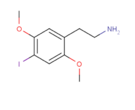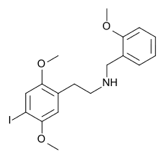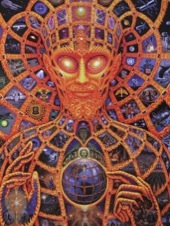Phantastica






25I-NBOMe is an experimental phenethylamine hallucinogen conceived as a cousin of the 2C compound family. The 2C family can be classified as any psychadelic phenethylamine that contains methoxy groups on the 2 and 5 carbons of its benzene ring. The substituents on carbons 3 and 4 give each 2C compound its unique biochemical properties, the most popular recreational 2C compound being 2C-I, which has a hydrogen on carbon 3 and an iodine on carbon 4 (see below).
The name 2C refers to the number of carbons between the amine group and the phenyl group in the phenethylamine structure, and the letter I comes from the iodine on the 4 carbon. The NBOMe family is classified as any N-o-methoxybenzyl analog of the 2C family. 25I-NBOMe is the N-o-methoxybenzyl analog of 2C-I (see below).


Like the 2C family, the 25I and the NBOMe family are strong agonists for the 5-HT2A serotonin receptor. 25I is active in the microgram range, like LSD, being in fact about 16 times more potent than its 2C cousin. It has such a high affinity for the 5-HT2A receptor that tritium-labelled 25I can actually be used to map the distribution of 5-HT2A receptors in the brain.
25I-NBOMe is itself not a natural product, but the phenethylamine motif from which it draws its potency is found ubiquitously in nature. Alex Shulgin, credited with the popularization of 2C-I and MDMA, based his life's work on the synthesis of phenethylamine analogs, inspired by the structure of mescaline. As very powerful 5-HT2A agonists, NBOMe compounds could contribute significantly to the neurochemical research of disorders like depression and schizophrenia, both of which can be partially attributed to 5-HT2A irregularities.
25I and the rest of the NBOMe family were in fact first synthesized by a team of German pharmaceutical chemists in 2003 whose intent was not for them to become recreational hallucinogens but to act as powerful 5-HT2A agonists for research. The 5-HT2A receptor is heavily involved in the biochemical mechanisms of depression, schizophrenia, hallucinations, perception and emotion: a more thorough understanding of this receptor and its regulation is paramount to treating complex psychological disorders.
Recently there has been promising research done on the use of psilocybin, a strong hallucinogen and 5-HT2A receptor agonist, for its therapeutic properties in the search for treatments of deeply-routed disorders such as PTSD. In the same way that psilocybin can be used therapeutically to induce in the patient feelings of “utter joy and freedom,” 25I-NBOMe could prove equally if not more effective. One quote from an experience account I came across stands out in my mind as evidence for its therapeutic properties: “The feeling I had was so incredible, I was filled with genuine sadness thinking about the lack of a relationship I have with my mother. It's hard for me to be honest with myself, but I do miss her and want to make more of an effort to get to know her. I began to cry thinking of the quote 'you only know what you have when it's gone'... This trip inspired me to reach out to many people in my life and strengthen the bonds that make life worth living.” The same account ends with the user quitting cigarettes: “shortly after taking the blotters, I broke my last cigarette in half and have not looked back since. Fuck that habit.” Whether the user actually followed through is a different story entirely, but the account hints that 25I could prove effective against addiction as well.
Anecdotal accounts of 25I's positive psychological effects, while hopeful, do nothing to prove its physiological safety, and much more research is needed before this drug would ever be considered for therapeutic administration. In the meantime, however, its unusually strong affinity for serotonin receptors and its simple structure make it the perfect research tool for elucidating the neurological mechanisms of unfortunately common psychological disorders. Whether it is used for healing on an individual level or used to discover the method behind different types of madness, 25I-NBOMe has the potential to give extremely valuable insights into the enigmatic human mind and the mystery of consciousness itself.
References
Griffiths et al. Mystical-type experiences occasioned by psilocybin mediate the attribution of personal meaning and spiritual significance 14 months later. Journal of Psychopharmacology
00 (00) (2008) 1–12.
http://en.wikipedia.org/wiki/25I-NBOMe
http://www.erowid.org/experiences/exp.php?ID=93644
http://www.huffingtonpost.com/craig-k-comstock/psychedelic-science_b_547070.html
Nichols DE, Frescas SP, Chemel BR, Rehder KS, Zhong D, Lewin AH (June 2008). "High Specific Activity Tritium-Labeled N-(2-methoxybenzyl)-2,5-dimethoxy-4-iodophenethylamine (INBMeO): A High Affinity 5-HT2A Receptor-Selective Agonist Radioligand". Bioorganic & Medicinal Chemistry 16(11): 6116–23.
Ralf Heim PhD. Synthese und Pharmakologie potenter 5-HT2A-Rezeptoragonisten mit N-2-Methoxybenzyl-Partialstruktur. Entwicklung eines neuen Struktur-Wirkungskonzepts. (German) Dissertation, Free University of Berlin, 2003.
“Every thought I had….I could feel it going from this neuron to that one, and on and on, I just began to understand the universe in a way it seems only God could.”
Monday, April 23, 2012



251-NBOMe - Bryce Rogers





